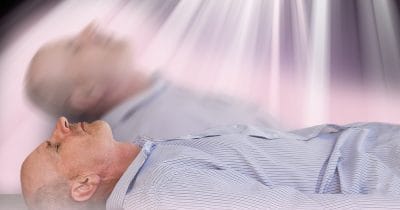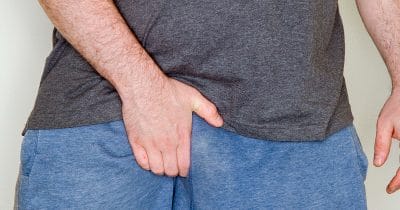
Did you know that rheumatoid arthritis is a collective term for more than 120 different conditions? All these different types cause painful muscles and joints, but the cause and treatment are different for each form.
Mark Walschot, a rheumatologist at UZ Antwerpen, tells us more about the six best-known forms of rheumatism and helps you to distinguish between them.

ARTHROSIS
WHAT IS IT?
Dr. Walschot: “Osteoarthritis is a disease in which the cartilage between the joints is affected. This makes it difficult for you to move and causes your joints to ache. We all start our lives with a certain amount of cartilage. How much and of what quality this is, is genetically determined. The older we get, the more our reserves of cartilage are depleted or the more likely it is to be damaged somewhere along the way. Smoking and obesity, for example, are pernicious and accelerate that process. Osteoarthritis is part of the aging process and therefore occurs in the older population. We also see it slightly more often in women than in men. The joints bearing the weight, such as the knees and hips, are usually the first to suffer, followed by the hands and back. You only rarely find osteoarthritis in the ankles and elbows.’
HOW DO YOU RECOGNIZE IT?
‘Within rheumatology we make a distinction between mechanical and inflammatory problems. Osteoarthritis is a mechanical problem. You can compare it with a car whose mechanics have failed. Mainly when standing up there is stiffness, but once you are in it goes better. If you put too much strain on your joints, the symptoms increase. That is why patients with osteoarthritis usually suffer more in the evening. Cartilage ensures that the pressure in a joint is evenly distributed. If that cartilage is gone, the pressure increases. Reducing that pressure again is done by increasing the surface area. That’s how extra bone forms, and you see hard lumps on the joints, crooked fingers and other deformities in osteoarthritis patients at an advanced stage.’

TREATMENT
‘Unfortunately there is no treatment that cures osteoarthritis, we can only help to alleviate the problems. In case of pain, we find out which painkillers provide relief. We also try to keep our patients moving as much as possible, because rest really does rust. The better trained the muscles and tendons are, the easier it is to get the damaged joints moving. Much has been said and written about foods that are thought to affect cartilage, although there is still controversy about this. If it doesn’t help, I would say it doesn’t hurt. Is the joint very badly damaged and does the osteoarthritis have a major impact on the patient’s life? Then the orthopedist can decide to replace it with a prosthesis. Important to know: this is only done for large joints, such as the knees.’
OSTEOPOROSIS
WHAT IS IT?
‘Osteo’ means bone and ‘porose’ porous. So osteoporosis literally means that your bones become porous or in other words, that the bone quality deteriorates. The balance between bone formation and bone breakdown is no longer equal. Osteoporosis also occurs with age. Our bone quality peaks around the age of 25 to 30 years and only deteriorates after that. At some point you reach a critical limit, where the risk of breaking something increases. The difficulty here is that many people have osteoporosis without knowing it themselves. We speak of osteoporosis when there is too little calcium in the bones, but that does not mean that there is also an increased risk of fractures. So we don’t always have to treat osteoporosis as such, only when the risk of fracture is too high.
HOW DO YOU RECOGNIZE IT?
Osteoporosis doesn’t hurt, so you don’t notice much. Usually, you only find out when you break something in a stupid way and have your bones examined. It particularly affects women after menopause. That’s because bone production is greatly reduced once the body produces less estrogen and progesterone.
TREATMENT
‘Prevention is the most important thing here. Especially younger people who don’t have osteoporosis yet should try to get their bone mass as high as possible. If that reserve is high, then the bone quality should already be seriously reduced before you reach the critical zone. You do that by consuming enough dairy products or products high in calcium.’
‘Exercise is also necessary. Especially movements with resistance are good, because the bones react to them, making them firmer. Smoking is very bad for bone quality and alcohol is not ideal either. Older people can benefit from extra supplements of vitamin D and calcium. And if we are really dealing with an increased billing risk, we can start treatments that stop bone degradation. Nowadays there is even medication that not only inhibits bone degradation but also stimulates bone formation. Unfortunately, this is still very limited.

GOUT
WHAT IS IT?
Gout is one of the most common forms of rheumatism, which we mainly see in people in their forties and fifties. Simply explained, gout is caused by crystals of uric acid that settle in the joint – usually the big toe or foot – where they cause inflammation. Uric acid is a breakdown product of our DNA, which normally leaves the body through our urine. If that does not work, it forms crystals and looks for a storage place in the body. Joints are the ideal place for this.’
HOW DO YOU RECOGNIZE IT?
Gout causes red, painful and swollen joints. After a few days, it disappears on its own, but until then the patient can barely keep up with the pain. You can’t even look at it, so to speak, or the patient is already screaming. Sometimes it goes better for a week, but after that, the pain can quickly return. We still associate gout with drunks. It is true that alcohol can promote gout, but it is certainly not the only cause. People with kidney problems can also get gout because sometimes the uric acid cannot leave the body. In addition, certain medications also cause uric acid to accumulate in the blood.’
TREATMENT
Does a joint hurt extremely badly? Then we first inhibit the inflammation. We do that by administering the classic anti-inflammatory. Afterward we work with colchicine, the most commonly used medicine for gout. Colchicine is a pill that slows down the inflammatory process of crystals. In addition, we must also give medication to decrease the amount of uric acid. Does the patient drink a lot of alcohol? If so, he or she must first reduce it, otherwise, the treatment will be of no use. Getting rid of the uric acid completely is also not a good idea. If the amount of uric acid in the blood drops sharply, our body thinks there is a deficiency and retrieves the crystals from the storage areas (read: the joints). This too can cause an inflammatory response. So if you’re taking medication to lower uric acid, you should always take another anti-inflammatory medication on top of it.
RHEUMATOID ARTHRITIS
WHAT IS IT?
‘Anyone who talks about rheumatoid arthritis is usually talking about this form. The word part ‘itis’ always means in medicine that it is about inflammation. So rheumatoid arthritis is an inflammatory disease. That means your immune system is attacking your own joints. There are a lot of theories about why this happens, but we’re not completely sure. It’s probably an accumulation of circumstances, with our genetics playing an important role. Once your immune system attacks your joints, it causes pain and stiffness. If we don’t do anything about it, the joint becomes damaged and that is irreversible. It is therefore important that we catch it quickly. This form also occurs mainly in people in their forties and fifties. Among the patients, we again see slightly more women than men.’
HOW DO YOU RECOGNIZE IT?
In rheumatoid arthritis, the joints are swollen due to increased fluid production. While in osteoarthritis it is a hard lump, here there seems to be a balloon of water on the joint. This form of rheumatism is described in scientific books as ‘arthritis of the smaller joints. So we almost always see it on the first and second knuckles of the hands. The wrists are also often affected. Several joints may also be affected. In inflammatory diseases, the pain is different and patients wake up at night because of it. No matter how much they twist or turn, the pain does not go away. Usually, it does improve a little during the day and the symptoms largely subside by the evening.’
TREATMENT
‘We treat rheumatoid arthritis – and by extension all inflammatory forms of rheumatism – by adjusting the immune system. There are many treatment options for this. Often in the first phase we use cortisone, still our fastest and most powerful anti-inflammatory. This allows us to achieve quick results, but it is never the intention to use cortisone in the long term. After a while, another drug must be used to suppress the inflammatory process. In recent years we have made a lot of progress, so that there are new treatment options. The specter of joints that become completely damaged because we cannot control the inflammation is no longer present. A patient who is diagnosed today should have no deformities in twenty, thirty or forty years.’
JUVENILE RHEUMATISM
WHAT IS IT?
‘Juvenile rheumatism belongs to the same family as rheumatoid arthritis. Here, too, the immune system attacks the body. We speak of juvenile rheumatism when the disease is diagnosed before the age of sixteen. Juvenile rheumatism can even occur as early as one year of age. Moreover, it can have very serious consequences later in life. In addition to the joints being damaged, the disease can also affect the growth plates. Whether or not juvenile rheumatism also affects you later in life depends on how quickly the diagnosis is made and how well the treatment works or how long the disease has been causing damage. The damage that occurs before the age of five has lifelong consequences.’

HOW DO YOU RECOGNIZE IT?
‘In juvenile arthritis, the immune system also attacks the organs. So not only the joints, but also the eyes and the skin, among others, can suffer. In fact, the joints do not always have to be in the foreground in this case. Other symptoms are fever and emaciation.’
TREATMENT
‘Like other inflammatory diseases, juvenile rheumatism is a problem of the immune system and we need to adjust it. Since we’re dealing with children, we can’t use the same heavy-duty medications as we do with adults. In extreme cases, we sometimes do. We can’t just take away the immune system and then give a new one in its place. What we can do is keep the programming flaw in the immune system from surfacing, so that you are barely affected. When we talk about ‘curing’ we usually mean that we have found medication that makes it easy for you to live with the disease. Fortunately, you don’t have to take medication for life in every case. If the disease is under control, you may be able to stop taking it completely, which of course depends on how aggressive the rheumatism is.’
LUPUS
WHAT IS IT?
‘Also in lupus, the immune system attacks the body. The disease can take different forms. In lupus, inflammation does not necessarily arise in the joints. Fortunately, it is a rare disorder. The typical lupus patient is a young woman about twenty years old. It occurs after menstruation has fully broken. Before that, we don’t see it very often, and even after menopause, it is rare.
HOW DO YOU RECOGNIZE IT?
‘The symptoms, of lupus are very varied and can range from some small skin lesions to kidney or even lung failure. The most common symptom is a house rash that occurs mainly after exposure to the sun. We’re not talking about a little redness here, but really a rash that lasts for a few days and doesn’t just go away. In addition, you can also suffer from swollen joints. But as I said, it’s very difficult to link one disease picture to this.’
TREATMENT
It is of course important to first find out exactly how serious the disease is. It goes without saying that you get different treatment for a spot on your skin than when your kidneys fail. Just like other inflammatory diseases, the immune system is the culprit. Therefore, even in lupus, it is important to polish the immune system. We do that in the same way we do with rheumatoid arthritis.’

WHAT ABOUT FIBROMYALGIA?
‘There is still a lot of debate among rheumatologists about fibromyalgia and whether or not it belongs to the rheumatic diseases,’ says Mark Walschot. All forms of rheumatism result in pain, stiffness, and difficulty in functioning. You can measure that pain in some way: be it in the blood or on a photograph.’
‘That’s not the case with fibromyalgia. Muscle and joint pains are often the main symptom, but there are also other complaints, such as headaches and stomach aches. We still don’t really know which symptoms go together and how to put that puzzle together. You often hear it said that fibromyalgia is between the ears, but I disagree. Just because we can’t explain it doesn’t mean there’s nothing seriously wrong.’





